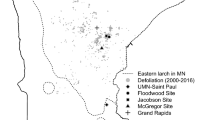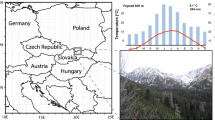Abstract
Larch casebearer is an invasive defoliator in North America distributed within the regions of two allopatric hosts, eastern larch and western larch. Despite the establishment of a successful importation biological control program and ongoing parasitism by both native and introduced parasitoids, larch casebearer has recently undergone outbreaks on eastern larch and western larch. We analyzed defoliation data from aerial surveys to quantify spatiotemporal synchrony and found that defoliation by larch casebearer was synchronous both within and between eastern and western larch forests. We also analyzed monthly minimum temperatures across the study region and found that warming spring temperatures in March and cooling fall/winter temperatures in October through December were positively correlated at distances comparable to those between the allopatric outbreaks of larch casebearer. For allopatric populations with positively correlated population dynamics, climate is the most likely driver of synchrony. Thus, we suggest that a changing climate has facilitated recent outbreaks of larch casebearer.





Similar content being viewed by others
References
Bale JS, Hayward SAL (2010) Insect overwintering in a changing climate. J Exp Biol 213:980–994
Bale JS, Masters GJ, Hodkinson ID et al (2002) Herbivory in global climate change research: direct effects of rising temperature on insect herbivores. Glob Change Biol 8:1–16
Becker RA, Wilks AR, Brownrigg R et al (2018) maps: draw geographical maps. R package version 3.3.0. https://CRAN.R-project.org/package=maps. Accessed 1 Oct 2018
Bivand R, Keitt T, Rowlingson B (2018) rgdal: bindings for the “Geospatial” Data Abstraction Library. R package version 1.3-3. https://CRAN.R-project.org/package=rgdal. Accessed 1 Oct 2018
Bjørnstad ON (2018) ncf: spatial covariance functions. R package version 1.2-5. https://CRAN.R-project.org/package=ncf. Accessed 1 Oct 2018
Bjørnstad ON, Falck W (2001) Nonparametric spatial covariance functions: estimation and testing. Environ Ecol Stat 8:53–70
Brunsdon C, Chen H (2014) GISTools: some further GIS capabilities for R. R package version 0.7-4. https://CRAN.R-project.org/package=GISTools. Accessed 1 Oct 2018
Core Team R (2018) R: a language and environment for statistical computing. R Foundation for Statistical Computing, Vienna
Crocker SJ, Liknes GC, McKee FR et al (2016) Stand-level factors associated with resurging mortality from eastern larch beetle (Dendroctonus simplex LeConte). For Ecol Manag 375:27–34
Flowers R, McWilliams M, Hostetler B et al (2009) Forest health highlights in Oregon. Oregon Dep For and USDA For Serv
Flowers R, Kanaskie A, McWilliams M et al (2010) Forest health highlights in Oregon. Oregon Dep For and USDA For Serv
Flowers R, Kanaskie A, Williams W et al (2013) Forest health highlights in Oregon. Oregon Dep For and USDA For Serv
Graham AR (1948) Developments in the control of the larch casebearer, Coleophora laricella (Hbn.). In: 79th Annu Rep Entomogical Soc Ontario, pp 45–50
Hagen HA (1886) Coleophora laricella Hb. very injurious to Larix europea, in Massachusetts. Can Entomol 18:125–126
Hance T, van Baaren J, Vernon P, Boivin G (2007) Impact of extreme temperatures on parasitoids in a climate change perspective. Annu Rev Entomol 52:107–126
Hart EM, Bell K (2015) prism: download data from the Oregon prism project. R package version 0.0.6. http://github.com/ropensci/prism. Accessed 10 May 2017
Hijmans RJ (2017) raster: geographic data analysis and modeling. R package version 2.6-7. https://CRAN.R-project.org/package=raster. Accessed 1 Oct 2018
Jeffs CT, Lewis OT (2013) Effects of climate warming on host-parasitoid interactions. Ecol Entomol 38:209–218
Johnson SL, Stefan HG (2006) Indicators of climate warming in Minnesota: lake ice covers and snowmelt runoff. Clim Change 75:421–453
Liebhold A, Koenig WD, Bjørnstad ON (2004) Spatial synchrony in population dynamics. Annu Rev Ecol Evol Syst 35:467–490
Little EL (1971) Atlas of United States trees, volume 1, conifers and important hardwoods. U.S. Department of Agriculture Miscellaneous Publication 1146
Miller-Pierce M, Shaw DC, Demarco A, Oester PT (2015) Introduced and native parasitoid wasps associated with larch casebearer (Lepidoptera: Coleophoridae) in western larch. Environ Entomol 44:27–33
Minnesota Department of Natural Resources (2001) Minnesota forest health annual report
Nelson A, Sprengel K, Flowers R et al (2007) Forest health highlights in Oregon. Oregon Dep For and USDA For Serv
Økland B, Liebhold AM, Bjørnstad ON et al (2005) Are bark beetle outbreaks less synchronous than forest Lepidoptera outbreaks? Oecologia 146:365–372
Otvos IS, Quednau FW (1981) Chapter 49-Coleophora laricella (Hübner), larch casebearer (Lepidoptera: Coleophoridae). In: Kelleher JS, Hulme MA (eds) Biol control program against insects weeds Canada, 1969–1980. Commonw Agric Bur London, England, pp 281–284
PRISM (2017) PRISM Climate Group, Oregon State University. http://prism.oregonstate.edu. Accessed 10 May 2017
Ryan RB (1974) Laboratory reactivation of diapausing larch casebearer larvae following different lengths of winter exposure. USDA For Serv Res Note (PNW:218)
Ryan RB (1990) Evaluation of biological control: introduced parasites of larch casebearer (Lepidoptera: Coleophoridae) in Oregon. Environ Entomol 19:1873–1881
Ryan RB (1997) Before and after evaluation of biological control of the larch casebearer (Lepidoptera: Coleophoridae) in the Blue Mountains of Oregon and Washington, 1972–1995. Environ Entomol 26:703–715
Ryan RB, Tunnock S, Ebel FW (1987) The larch casebearer in North America. J For 85:33–39
Schmidt WC, Shearer RC, Roe AL (1976) Ecology and silviculture of western larch forests. Technical Bulletin No. 1520, USDA Forest Service, p 96
Tunnock S, Ryan RB (1985) Larch casebearer in western larch. USDA For Serv For Insect Dis Leafl 96:1–7
Van Asch M, Visser ME (2007) Phenology of forest caterpillars and their host trees: the importance of synchrony. Annu Rev Entomol 52:37–55
Visser ME, Both C (2005) Shifts in phenology due to global climate change: the need for a yardstick. Proc R Soc B 272:2561–2569
Ward SF (2018) The role of climate in outbreaks of larch casebearer. PhD Dissertation, University of Minnesota, Saint Paul, Minnesota, United States of America
Ward SF, Venette RC, Aukema BH (2018) Cold tolerance of the invasive larch casebearer and implications to invasion success. Agric For Entomol. https://doi.org/10.1111/afe.12311
Webb FE, Quednau FW (1971) Chapter 38-Coleophora laricella (Hübner), larch casebearer (Lepidoptera: Coleophoridae). Biol Control Program Against Insects Weeds Canada, 1959–1968, Tech Commun No 4 131–136
Westerling AL, Hidalgo HG, Cayan DR, Swetnam TW (2006) Warming and earlier spring increase western U.S. forest wildfire activity. Science 313:940–943
Acknowledgements
Funding was provided by USDA Forest Service award 15-DG-1142004-237, the College of Food, Agricultural, and Natural Resource Sciences at the University of Minnesota, Minnesota Agricultural Experiment Station project MIN-17-082, and a University of Minnesota Doctoral Dissertation Fellowship to SW. We thank two anonymous reviewers for their helpful critiques.
Author information
Authors and Affiliations
Corresponding author
Electronic supplementary material
Below is the link to the electronic supplementary material.
Rights and permissions
About this article
Cite this article
Ward, S.F., Aukema, B.H. Climatic synchrony and increased outbreaks in allopatric populations of an invasive defoliator. Biol Invasions 21, 685–691 (2019). https://doi.org/10.1007/s10530-018-1879-9
Received:
Accepted:
Published:
Issue Date:
DOI: https://doi.org/10.1007/s10530-018-1879-9




